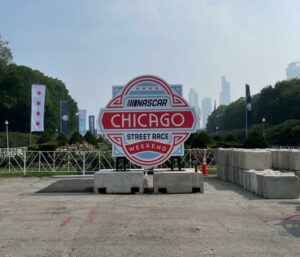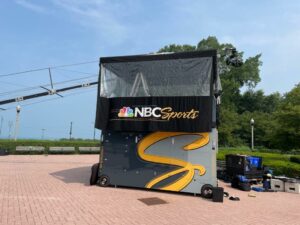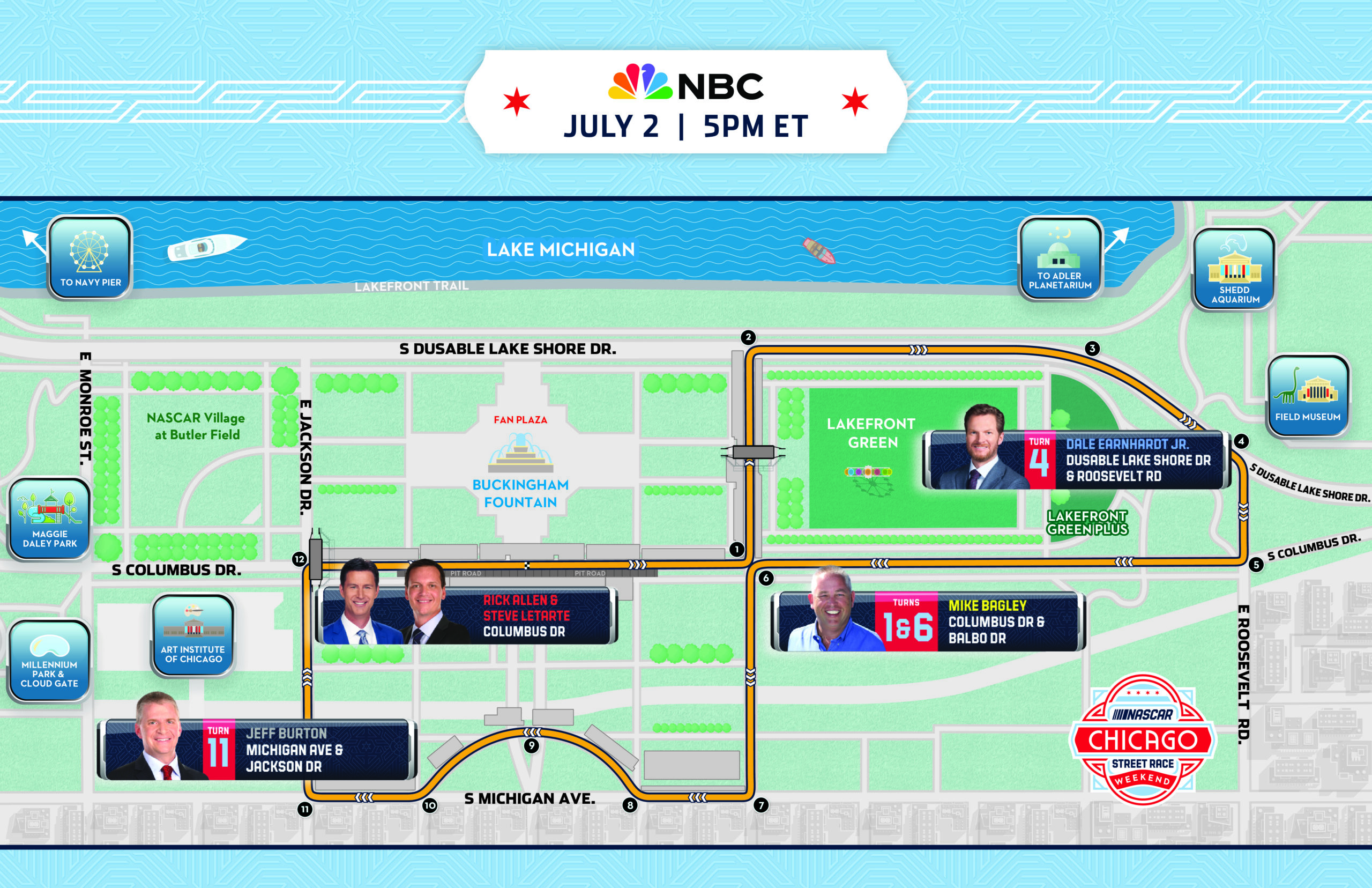NBC Sports ‘Throwing the Kitchen Sink’ at NASCAR Chicago Street Race
NBC says first NASCAR Cup Series street-course event promises to be ‘our Daytona 500’
Story Highlights
NBC Sports Tech Manager Matt Hogencamp calls the first-ever NASCAR Cup Series Street Race, scheduled to take place in Chicago on Sunday, July 2, “our high-water mark.” More than 90 cameras are expected to be deployed, including 11 hard cameras, five RF cameras, six wired handhelds, eight super-slo-mos, and 25 robotic systems. A1 Bryan Korot describes the event as “our Daytona 500.”
In short, everyone is looking for an analogy to describe something they’ve never experienced before.
For Korot, the uniqueness of the situation — the first-ever NASCAR Cup race held on a downtown street course — was driven home when he did some remote walk-throughs of the route with driver and NBC Sports pit reporter Parker Kligerman.
“Before,” Korot says, “we had been looking at renderings and graphics showing nice trees and parks; it looked more like Miami. Then you see the buses and the cabs, and it really hits you: this is downtown Chicago, and they’re going to run a race here.”

NASCAR takes to the streets of Chicago on Sunday, July 2.
He expects to have about 10 Calrec Hydra boxes deployed along the course, along with several Dante throw-down boxes specifically for roar mics. The actual mic count is still being calculated, but the likely camera count is around 90, and each will have a microphone attached.
The audio crew will also be commensurately larger: Korot counts 15 staffers, versus the 11 typically on hand, and two A2s are assigned to an overnight shift to deploy microphones as the city closes the street ahead of the race.
Submixer Steve Urick, working from Game Creek Edit 1, will have his hands full. The track layout will likely cause cars to bunch up in certain turns, significantly increasing the SPL at those points. That sound, picked up by one of the dozens of stereo mics attached to cameras at the turns, will be managed the old-fashioned way: with fingers on faders and the occasional mic pad and some optimistically pre-adjusted gain levels.
The real unknown in the race, though, is the new NASCAR exhaust design, part of the Next Gen car design introduced last year. This race will be only the second time NASCAR Cup cars are outfitted with mufflers, part of the actions being taken by race organizers to head off concerns about noise; in the future, they will be used only on short tracks and street courses.
“This time, [the organizers] went with headers and side pipes on both sides of the car, which is a dramatic difference from the [previous] Xfinity and Cup cars,” explains Urick, who will also be mixing a stereo microphone in each car, handled by wireless provider BSI, delivering interior ambient sound around the driver/crew comms on-air. “On those, the sound came mostly from one side only. Here, we’ll have to listen for when the downshifts and RPM changes occur, and that will depend on how some drivers ride the brakes instead of shifting where we’d expect them to. Some will, some won’t.
“The big challenge,” he continues, “will be building and managing over 80 inputs across multiple layers of the console, keeping up with the possibilities of each lap as well as with where [director] Sean Owens is taking it: a turn can either be a camera on a lift or a robo down low. Either way, the audio has to follow it.”
Video is also bigger and with some new wrinkles. Hogencamp forecasts an unprecedented nine dual-path cameras per car, for a total of 36 in-car cameras during the race. The potential for new angles will be amazing, he says.

A view of NBC Sports’ Peacock Pit Box in Grant Park.
“The new in-car [cameras],” he explains, “will do a cut from hanging alongside and, [as the driver goes] to pass somebody, looking at the side pan or cutting to the rear-bumper camera to be able to show the car as they go past it. There’ll be 36 options of ways to show what’s happening literally on the track in Chicago.”
The Windy City races will also have two drones, from NBC Sports’ partner Beverly Hills Aerial, with one up in the air at all times, transmitting via BSI. According to Hogencamp, the smaller of the two, the Hummingbird, can reach into spaces that the more powerful larger drones can’t get to because of their size and noise.
“We’re throwing the kitchen sink at Chicago,” he laughs. “That’s going to be our prime event for this year. The amount of planning that has gone into that and bringing everything together is enormous. I did my first site survey in October while we were still in our NASCAR season and have been living and breathing it ever since. We’re looking at it and planning for it the same way we do for the Indy 500. It’s going to be a spectacle is how I would describe it. It’s going to be a showcase this year for NBC’s NASCAR coverage.”
‘The Ultimate Challenge’: Televising a Brand-New Race
NBC Sports VP, NASCAR Production and Motorsports, Jeff Behnke; producer Rene Hatlelid; and director Sean Owens mapped out the camera positions for the first-ever production.
“It’s the ultimate challenge to be the first people to televise a race at a course that has never been televised before,” says NBC Sports Executive Producer Sam Flood. “Obviously, the sense of space and the spectacle of being in the middle of the city is important. [We’re] going to shoot the race a little bit differently. You’ve got to shoot it to capture the size and the scope of what is being executed here. We’re going to have two drones flying around to capture that energy. We’ll have an overhead helicopter that’s able to give us the spectacle as well.”

In addition, a virtual simulation of the track that the drivers have practiced on has aided NBC in deciding where cameras are best- positioned. However, Flood acknowledges that nothing is certain until the green flag is dropped.
“Until you see the cars actually driving on the track,” he says, “you don’t know for certain how they’ll execute. We’re going to be ready to adjust after the practices take place and after the Xfinity race on Saturday. We’re excited, confident, and eager to showcase the city of Chicago, the sport of NASCAR, and the opportunity to grow the sport to a new audience on an American celebration weekend.”
Both races from Chicago will be presented “Radio Style,” NBC Sports’ fan-favorite broadcast style with announcers positioned at vantage points around the track and offering high-paced, around-the-horn commentary.
“The cars will go from announcer to announcer to announcer as they navigate the racetrack,” Flood explains. “Jeff Burton will be in one corner and throw it off to Dale [Earnhardt] Junior in the other. Steve Letarte will be with Rick Allen somewhere else, and Mike Bagley will be elsewhere on the track. We’re going to have all the bells and whistles that make big events bigger, which is one of our big philosophies at NBC.”
Jason Dachman contributed to this story.
